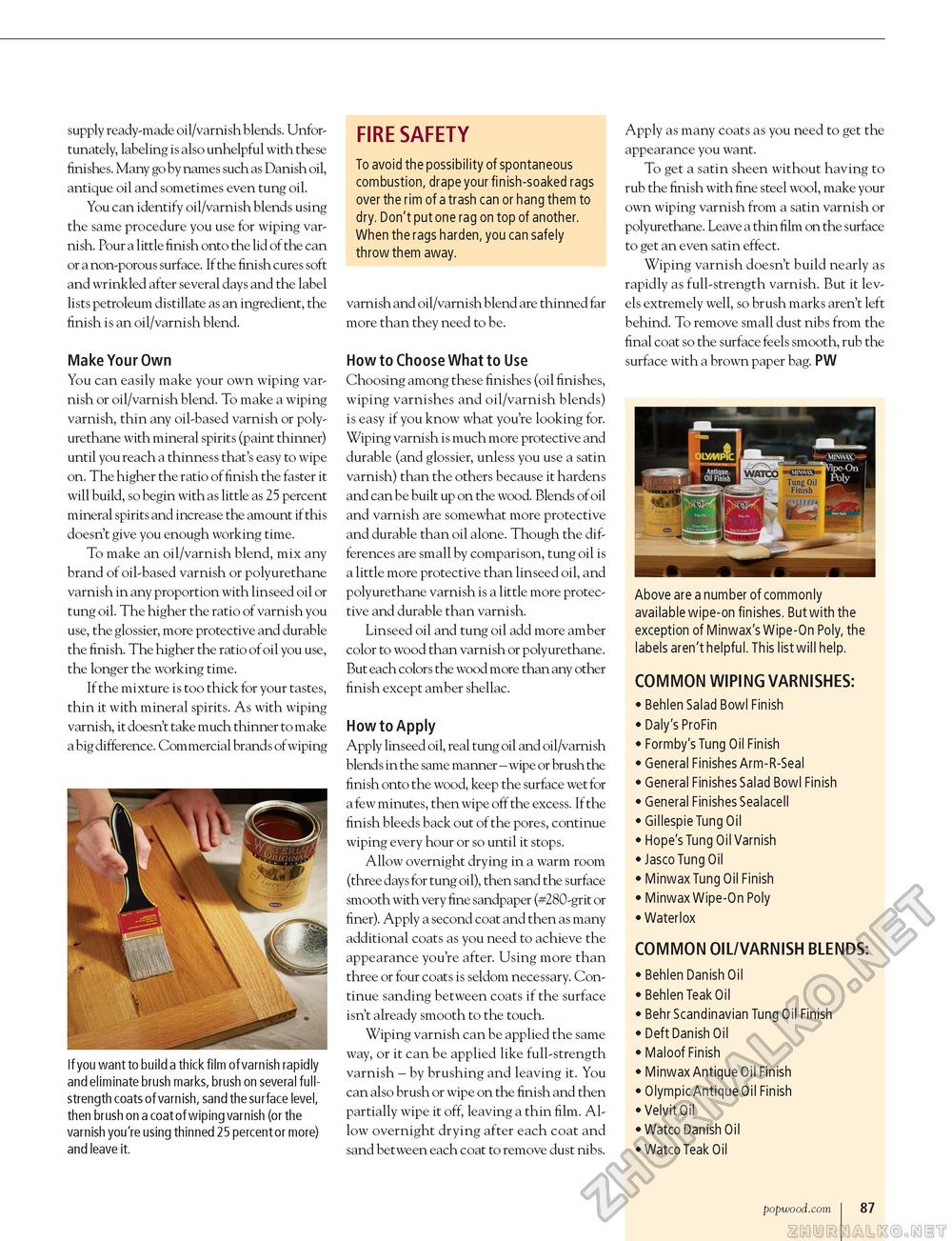Popular Woodworking 2004-08 № 142, страница 89
supply ready-made oil/varnish blends. Unfortunately, labeling is also unhelpful with these finishes. Many go by names such as Danish oil, antique oil and sometimes even tung oil. You can identify oil/varnish blends using the same procedure you use for wiping varnish. Pour a little finish onto the lid of the can or a non-porous surface. If the finish cures soft and wrinkled after several days and the label lists petroleum distillate as an ingredient, the finish is an oil/varnish blend. Make Your Own You can easily make your own wiping varnish or oil/varnish blend. To make a wiping varnish, thin any oil-based varnish or poly-urethane with mineral spirits (paint thinner) until you reach a thinness that's easy to wipe on. The higher the ratio of finish the faster it will build, so begin with as little as 25 percent mineral spirits and increase the amount if this doesn't give you enough working time. To make an oil/varnish blend, mix any brand of oil-based varnish or polyurethane varnish in any proportion with linseed oil or tung oil. The higher the ratio of varnish you use, the glossier, more protective and durable the finish. The higher the ratio of oil you use, the longer the working time. If the mixture is too thick for your tastes, thin it with mineral spirits. As with wiping varnish, it doesn't take much thinner to make a big difference. Commercial brands of wiping If you want to build a thick film of varnish rapidly and eliminate brush marks, brush on several full-strength coats of varnish, sand the surface level, then brush on a coat of wiping varnish (or the varnish you're using thinned 25 percent or more) and leave it. FIRE SAFETY To avoid the possibility of spontaneous combustion, drape your finish-soaked rags over the rim of a trash can or hang them to dry. Don't put one rag on top of another. When the rags harden, you can safely throw them away. varnish and oil/varnish blend are thinned far more than they need to be. How to Choose What to Use Choosing among these finishes (oil finishes, wiping varnishes and oil/varnish blends) is easy if you know what you're looking for. Wiping varnish is much more protective and durable (and glossier, unless you use a satin varnish) than the others because it hardens and can be built up on the wood. Blends of oil and varnish are somewhat more protective and durable than oil alone. Though the differences are small by comparison, tung oil is a little more protective than linseed oil, and polyurethane varnish is a little more protective and durable than varnish. Linseed oil and tung oil add more amber color to wood than varnish or polyurethane. But each colors the wood more than any other finish except amber shellac. How to Apply Apply linseed oil, real tung oil and oil/varnish blends in the same manner - wipe or brush the finish onto the wood, keep the surface wet for a few minutes, then wipe off the excess. If the finish bleeds back out of the pores, continue wiping every hour or so until it stops. Allow overnight drying in a warm room (three days for tung oil), then sand the surface smooth with very fine sandpaper (#280-grit or finer). Apply a second coat and then as many additional coats as you need to achieve the appearance you're after. Using more than three or four coats is seldom necessary. Continue sanding between coats if the surface isn't already smooth to the touch. Wiping varnish can be applied the same way, or it can be applied like full-strength varnish - by brushing and leaving it. You can also brush or wipe on the finish and then partially wipe it off, leaving a thin film. Allow overnight drying after each coat and sand between each coat to remove dust nibs. Apply as many coats as you need to get the appearance you want. To get a satin sheen without having to rub the finish with fine steel wool, make your own wiping varnish from a satin varnish or polyurethane. Leave a thin film on the surface to get an even satin effect. Wiping varnish doesn't build nearly as rapidly as full-strength varnish. But it levels extremely well, so brush marks aren't left behind. To remove small dust nibs from the final coat so the surface feels smooth, rub the surface with a brown paper bag. PW Above are a number of commonly available wipe-on finishes. But with the exception of Minwax's Wipe-On Poly, the labels aren't helpful. This list will help. common wiping varnishes: • Behlen Salad Bowl Finish • Daly's ProFin • Formby's Tung Oil Finish • General Finishes Arm-R-Seal • General Finishes Salad Bowl Finish • General Finishes Sealacell • Gillespie Tung Oil • Hope's Tung Oil Varnish • Jasco Tung Oil • Minwax Tung Oil Finish • Minwax Wipe-On Poly • Waterlox common oil/varnish blends: • Behlen Danish Oil • Behlen Teak Oil • Behr Scandinavian Tung Oil Finish • Deft Danish Oil • Maloof Finish • Minwax Antique Oil Finish • Olympic Antique Oil Finish • Velvit Oil • Watco Danish Oil • Watco Teak Oil popwood.com 87 |








